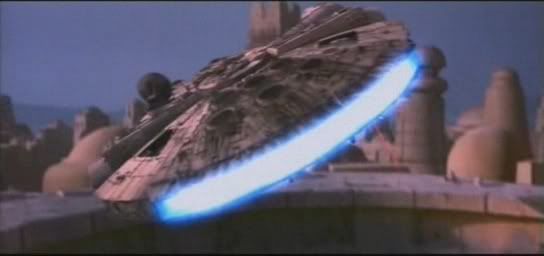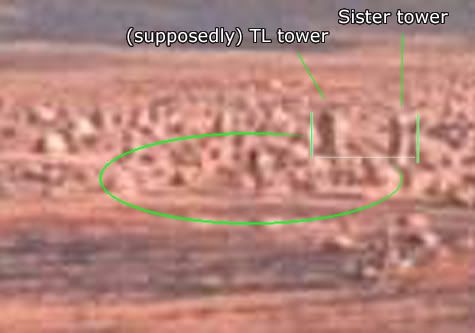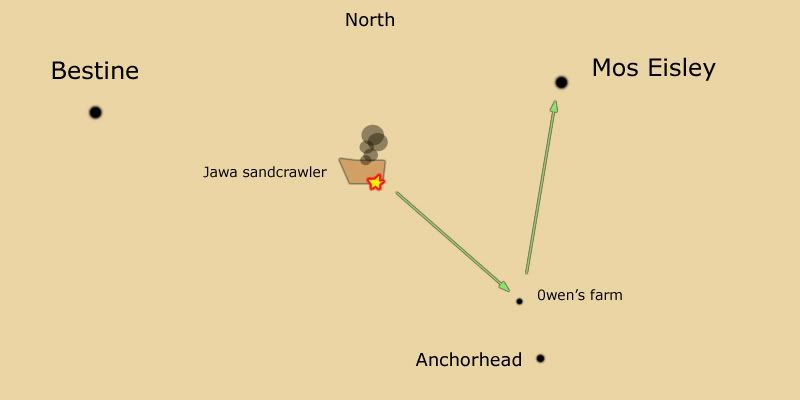Shining hairlines
Initially, I would have said that the beam fired from the hangar of one of the Venators was a better contender to that label. It's, in fact, particularily long, as being a constant beam, and somehow more "shiny" in certain ways.That said, the rocket booster of Sputnik 1 was visible as a magnitude 1 object compared to the polished half-meter of Sputnik itself, which was only mag 6. That's on par with the brightness of Saturn. It was a 28m by 3m cylinder that reached a height that isn't available in my research, but in any case it is said to have reached orbit and hung out there for a couple of months, suggesting that it maybe hit 100km or some similar LEO figure. For a painted-white, high-albedo, 28x3 vehicle to show as mag 1 still suggests that the turbolaser bolts, only about as bright as the reflected sunlight on the dingy ship hulls in the RotS battle when seen from afar, would've had to be quite large to be noticed.
Above all, it's actually extremely large and completely glaring white for two frames, before being focused into the less luminous beam.
That said, there are two problems with that anyway.
First, it's more an exception than anything else. As goes the idea that it's a SPHA-T beam of some sort, it has more to do with a trick of a particularily inspired commander, finding an oportunity to use one of the machines inside the hangar and use it against another starship, rather than a standard weapon which would fit the rather general description from the book.
Such a rarity can't fit with a description that talks about the vast bulk of fire exchanged between ships. That said, it's bad, because visuals hardly fit with the book's description. Since there's nothing on screen to be considered shining hairlines which would, above all, remain visible from the surface.
It would have us to think that the starships aren't firing their heavier turbolasers anymore. Which we know is untrue. We see Venators firing their main guns, like we see capital CIS ships firing their large caliber guns as well.
A theory would be that all those ships don't have much juice left, and aren't firing their cannons at maximum capacity.
It's not a far fetched idea at all.
If we consider EU sources for a moment, and use it only to fuel theories, we're told that SPHA-T means a SPHA type walker mounted with a heavy turbolaser, previously supercharged from the power core of the carrier it was parked in, as those walkers as unable to power their own weapon.
So in theory, it would seem that it's fairly easy to have cannons charged up, and remain like that for a long time. Thus it's likely that starships can also charge their cannons beforehand.
Going back to my previous point, it would mean that with those energy capacitors depleted, capital ships would now be powering their weapons directly from their respective cores' outputs.
It's quite interesting that the most luminous beam, and above all, the one that fits the best the book's description (written by an author who acknowledged trying to mesh as much EU as possible with the films' lore), as long and shiny hairline, is fired by a weapon that EU sources describe as working from previously charged capacitors.
The idea would be that those hairlines correspond to a moment of the Coruscant battle that is further away in the past, when the starships had their weapons' capacitors still sufficiently charged.
But that would be a double edged sword, meaning that firepower suddenly and immensely decreases when the capacitors are out, and that would also mean that the power cores don't provide large amounts of energy.
However, all that being nice, I don't think the description suggests that what it refers to happened hours ago.
Secondly (yes, the first point was quite long but I had to get it out), even if those SPHA-Ts were the true sources of those hairlines, the fact that the T corresponds to turbolaser, which for all intents and purposes, are just as big, if not bigger than the heavy turbolasers present on the Republic's heavier warships, means that the SPHA-T would be firing with guns which are the best and most powerful ones the Republic can bring to the table, and thus completely dismiss any idea that those SPHA-Ts were using medium or light turbolasers.
So, in conclusion, we're reaching the inevitable conclusion that we're orbiting around a description, depicting ongoing events, that does not match the visuals.
Therefore, there's no logic here claiming that the hairlines must be about the heavy bolts only, as there are simply no luminous and sufficiently elongated bolts to be labeled as shining hairlines visible from the surface at all.
Basically, that means we would be talking about any level turbolaser here, not necessarily the biggest ones.
Of course, a conservative stance is to assume that the heavier turbolasers were the one refered to, especially since they're the most likely to produce the most luminous bolts.
Mos Eisley's size
The derelict ship:
http://www.st-v-sw.net/images/Wars/Spec ... tower2.jpg
Your augmented overview montage:
http://www.st-v-sw.net/images/Wars/Spec ... a-mark.jpg
My own montage (an edit from your cap):
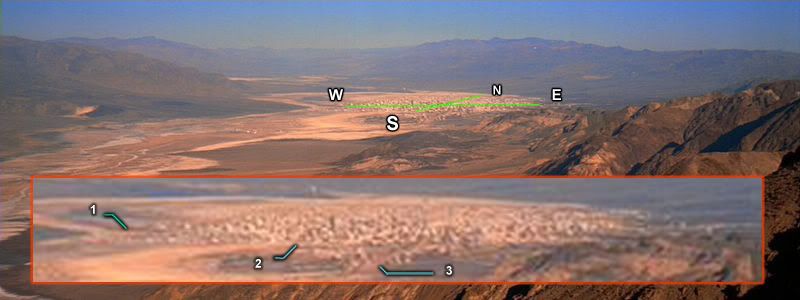
First and foremost, I'd say that any analysis based on shadows is condemned to be wrong, as shadow orientation is inconsistent in those scenes. It's not even consistent within a single pan.
In the Gallofree/docking bay 94 scene, they even manage to have two different blocks have shadows pointing in opposite directions.
I know there are twin suns in that stellar system, but please.
That said, there's one thing for sure. On the first of your images, the tip of the ship is pointing to the right of the screen, and we see that there's a long street in the background, with more tall buildings.
On the second picture, the large view of Mos Eisley, the structure that you circled has its tip, if it's a tip, pointing to the left.
We can also see that the structure is not far from the very edge of the city.
Considering the orientation of the structure you circled, there should actually be many buildings south of that structure (assuming south is behind us and north is in the background, at the horizon, on that wide view shot).
This serves to demonstrate that they're clearly not the same structure at all.
Besides, the structure you circled appears to be significantly bigger than the derelict craft, especially when you compare the size of people against it, and then the size of people against the tall square tower seen not far from docking bay 94.
The fact that the structure you circled sits on the edge of the city comes in opposition with the fact that Obi-Wan and Luke passed in front of that structure a while after entering the city.
They got inside the city with no sign of that crashed ship. We can see the square and round towers in the background, on the right side (again, don't pay atention to shadows):
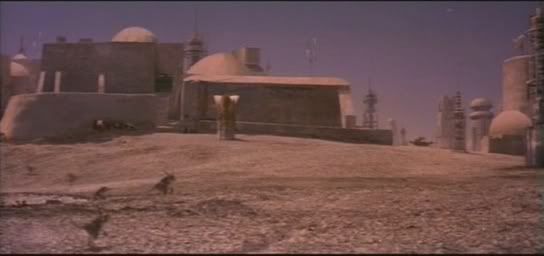
They glide across a large plaza with a big and rusted Gallofree medium cargo ship parked in the background, same as the kind used by the rebels:
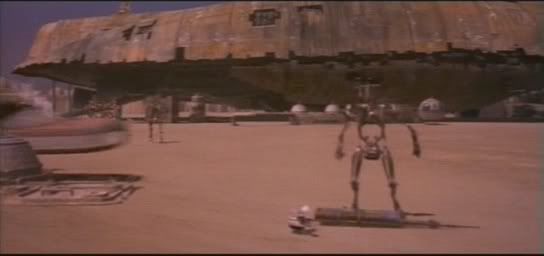
They continue straight on into one of the main streets:
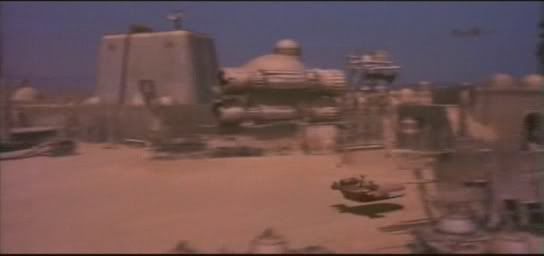
Going further towards the two towers, they pass not far from docking bay 94 (located nearby, somewhere on the right, offscreen):
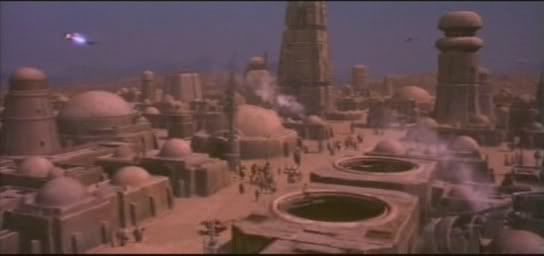
Then they go down a small street. We can appreciate the size of the buildings, especially those far behind, already caught in a blue haze:

Cross another place:
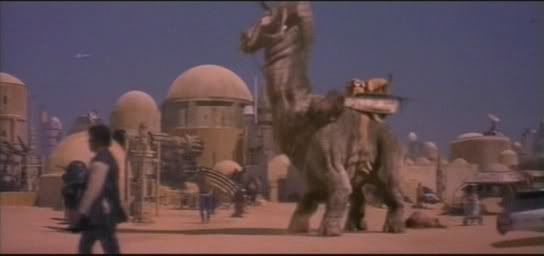
Then we see them driving down another narrow street, only to be forced to stop by an imperial patrol.
And only then, they pass in front of the derelict ship:

So obviously, we definitely agree, and confirm that the desolate piece of wreckage can't be located on the rim of the city, and is not that tall. According to the shadow of that piece of junk, its tip should be as high as the top of the screen, that is, significantly smaller than those 4-5 stories high buildings seen here and there, for eg. the Naboo-like structure in the shot of the derelict, in the far background, or those two towers in what could be Tatooine's central plaza.
This disputes the idea that the worn out ship is as tall as the higher buildings of Mos Eisley.
However, the silhouette you circled on the distant view of Mos Eisley clearly is one of the tallest structures of the city, so if you were to use it, you may rather look at a building easy twice as tall.
Besides, there's another element to consider.
When you look at the size of the central docking bays, and even the size of docking bay 94 (not to be confounded with these ones since they're smaller), when you notice how there's hardly even a medium concentration of them in that zone of the city (we only see those two small ones in fact - plus the 94 that's not far - despite the panning shot), like three docks per city block, in the most active part of the town, when you know that there must logically be around a hundred bays (from 1 to 94, plus eventually a few more, and not counting possible subtrees, as bay 52-A), that they're ought to be roughly as large, then you wonder how all of them can be cramped into a city that's supposedly 1 or 2 km wide, when we don't even get the chance to see more despite the numerous shots.
The smallest ships, able to provide all a pilot needs for long trips, are of the size of rebel fighters, like X-wings, which are roughly 12.5 meters long.
It's likely that many docking bays are for the small cargos (the medium ones, like the Gallofree, seem to directly land in open places) and personnal yatchs, considering the local activities.
Jedi starfighters are slightly smaller, but they don't come with their own hyperdrive, and the hyperdrive collar sitting in orbit is particularily big. Plus they're not the types of ships ought to be seen in such regions full of criminals and otehr smugglers.
Even when you look at the structures all around Mos Eisley, you realize that nearly all the buildings have either domes, or additional structures on their roofs, if not vast arrays of antennas. So they are not docking bays.
Vaporization definition
On this point, I won't claim that a layman type interpretation is out of question. It's logical to assume the author went for a rather comprehensible and commonly (mis)used term, contrary to a scientifically grounded definition, and I agree that the layman term is more than acceptable here, especially since the whole description is hardly metaphor free.
However, there's a point I disagree with on your "Thermal problem" article.
Contrary to the vast bulk of the structures present in Hiroshima when the bomb was dropped, most of those present in Mos Eisley are likely more massive and sturdier. They're less likely to be blown away by the shockwave fainting down to 3.5 psi.
The picture of the rased Hiroshima proves that the buildings built with beams of metal and forms of concrete were still up, while the rest of the surrounding landscape was flattened.
I'll also point to your Appendix A. It's rather clear that in agreement with the novelisation, numerous buildings of Mos Eisley use a lot that local adobe, old stone and double layers of durasteel. Even more, the light coloured surfaces of all the buildings could cause a phenomenom similar to the "white house" survival (at 3.5 psi that is, the colour would become irrelevant at 20 psi).
On this, more energy would be required to level such a city.
Now, we don't got the chance to see any quotes you'd have used for Appendix C, talking about durasteel in less than impressive terms. Those would be interesting to read.
If the author refered to the EU's durasteel, it seems to be quite an impressive material. Vader's artificial hand is made of such a material, yet I've heard of that story about how the glove survived the destruction of the Death Star, and even a trip through a sort of blackhole or whatever. I'm not sure.
On the other hand, all I could find with key words "durasteel definition", were those rather lame facts:
Bloodlines (Karen Traviss), Legacy of The Force:
What's the acceleration? Generally, the only number that's often omitted from a calc, despite being "present", is 1. So that's 1 m/s². Or, otherwise, big smelly BS."It's eighty kilos per square centimeter."
"What is?" asked Han, distracted.
"The yield stress of durasteel. You look like you're testing it."
Darksaber (Kevin J Anderson):
So they make their houses and ships out of this?Daala turned and ripped one of the electric-blue glowtorches from the floor behind her. "Enough!" she shouted. She raised the durasteel staff high and smashed it down upon the tabletop. The glowcrystal exploded into shards with crackling blue sparks, and transparent fragments flew in all directions. She hammered the rod down again and again, denting the table, bending the staff, and fragmenting the end.
Well, two favorite writer profiles for bounty hunters.
However, many EU sources talk about various forms of durasteel. Military grade, marks, for armour.
Remember the acceleration figures presented on another page of ST-v-SW.net. How could they be possible, if real durasteel was so craptastic?
Star Wars Encyclopedia, page 84:
"Durasteel: Used to build everything from from space vehiciles to dwellings, this ultralight metal can withstand radical temperature extremes and severe mechanical stress."
There seems to be various flavours of durasteel.
What about a description of durasteel from the novelisations? At least we could dismiss those absurd figures.
They're EU sources. We'd have to see what the higher sources say about that material.

